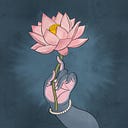Origins of Holikā Dahana

As per the Agni Purāṇa and Matsya Purāṇa, Diti, the daughter of Dakṣa, and Kaṣyapa had two sons: Hiranyakaṣipu (who is later killed by the Narasimha avatāra of Vishnu) and Hiranyakṣa (who was killed by the Varāha avatāra). Hiranyakaṣipu’s sister was named Simhika, who was married to Viprachitti and had two sons, named Rāhu and Ketu.
There is no mention of the rākṣaśi Simhika meeting her death through her participation in the attempted killing of Prahlada. In the Rāmāyaṇa, the demoness is later killed by Hanumān while on his way to Lanka.

Hiranyakaṣipu’s futile attempts kill the Viṣṇu bhakta Prahalāda are described in great detail in the Bhāgavata Purāṇa and Vishnu Purāṇa. Even in these accounts, Holika is not mentioned.

The first reference to Holika we find are in the Nārada Purāṇa as a rākṣaśi that causes fear in Prahlāda:

According to one account, Holika is the demoness Pūtana, who, in the Bhāgavata and Vishnu Purāṇas attempts to kill the baby Krishna by giving him her poisoned breasts to suck. The popular legend adds that the dead body of Pūtana was burnt in an effigy by the townspeople.


According to the Bhāvishya Purāṇa, probably the most reliable account of Holi, the Homa (Holika), observed on Phalguna pūrnima (Holi day) to ward off the evil Dhaundha rākṣaśi that frightened children.


The Vedic ritual of burning the Holikā fire is certainly ancient. We can safely make the assumption that folklore came to associate Dhaundha rākṣaśi with Simhika, Hiranyakaṣipu’s sister, and other rākṣaśis from the Purāṇas. In case she is thought of as Hiranyakaṣipu’s sister, she is a Brahmin woman, the daughter of Kaṣyapa. If we go simply by folklore, she is a rākṣaśi. To therefore call her a “bahujan” woman as some portals are doing, is baseless.
Sources:
- Nārada Purāṇa https://archive.org/details/dli.bengal.10689.12945…
2. https://dharmachaara.blogspot.com/2021/03/who-do-we-pray-on-holika-dahana.html…
3. The Religious Festivals of the Hindus by Wilson, H. H.; Published 1847 in the Journal of the Royal Asiatic Society of Great Britain and Ireland https://jstor.org/stable/pdf/25207635.pdf
______________________________________________________________
If you find value in my work, I hope you consider becoming a patron through Patreon. Hindu Aesthetic requires a lot of time and effort and your support would mean that I can continue bringing you the highest quality content. Link to my Patreon:
